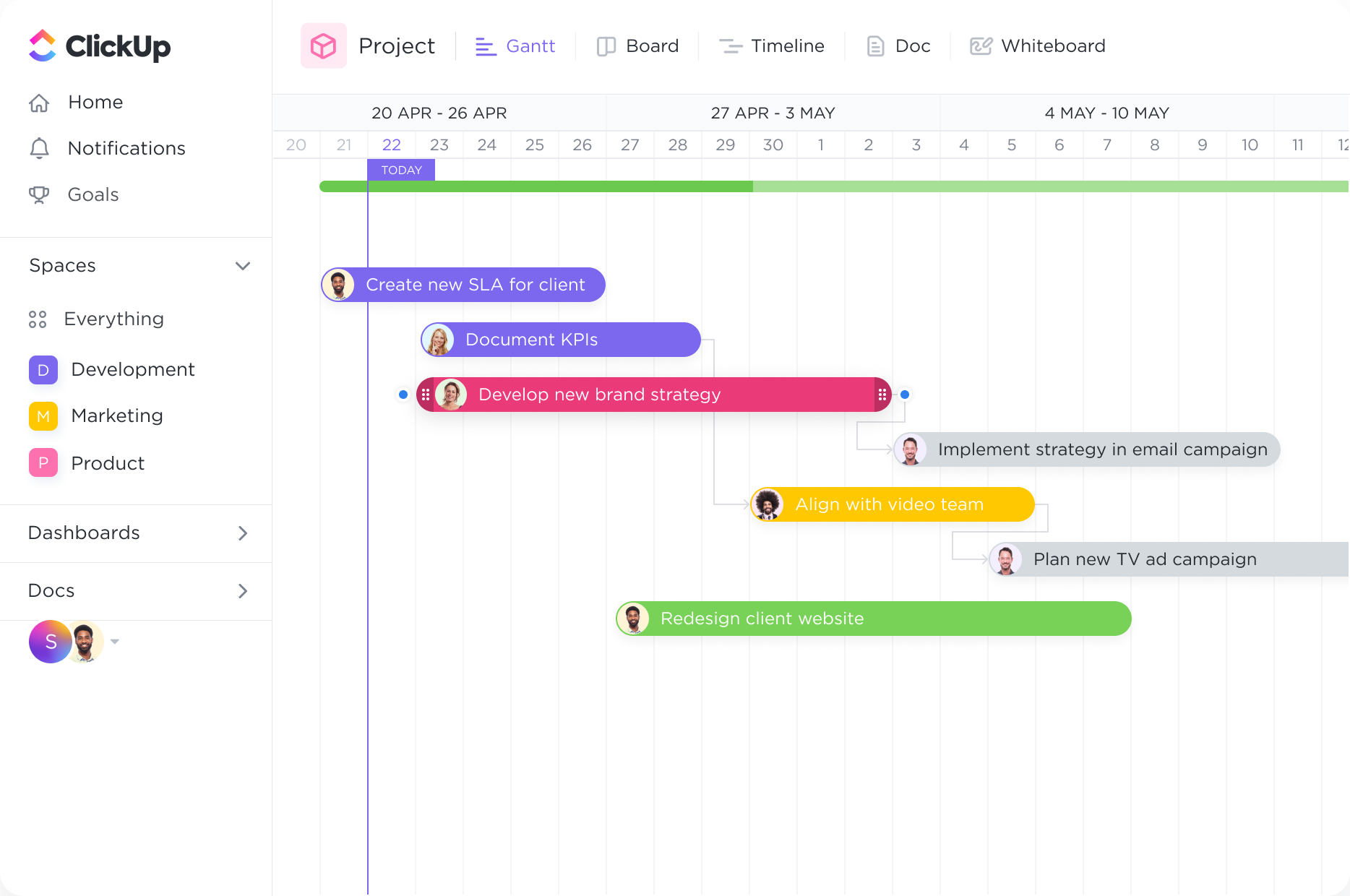Timelines
Stay ahead of every deadline.
With the Gantt chart's dynamic timeline, you can easily schedule tasks, keep up with project progress, manage deadlines, and handle bottlenecks.
Gantt Charts
Streamline your retail projects with ClickUp's powerful Gantt Chart software. Visualize your tasks, set dependencies, and track progress effortlessly. From inventory management to store renovations, ClickUp's intuitive interface empowers retailers to plan, execute, and deliver projects with precision and efficiency. Take control of your retail operations and achieve unparalleled success with ClickUp's Gantt Chart software.
Free forever. No credit card.

Timelines
With the Gantt chart's dynamic timeline, you can easily schedule tasks, keep up with project progress, manage deadlines, and handle bottlenecks.
Tracking
Intelligent dependency-path tracking shows you where potential bottlenecks might exist to prevent inefficiencies.
Retailers often undergo renovations and remodels to improve store layouts, enhance customer experiences, and update branding. Gantt charts can be used to visualize the various phases of these projects, such as planning, design, construction, and final touches. This helps retailers track progress, allocate resources, and ensure that the project stays on schedule.
When launching new products or running promotional campaigns, retailers need to coordinate various tasks and timelines. Gantt charts provide a clear overview of the activities involved, such as product development, marketing strategies, inventory management, and sales targets. By visualizing these elements, retailers can ensure that all necessary steps are taken and deadlines are met for successful product launches and promotions.
Effective inventory management is crucial for retailers to meet customer demands and optimize sales. Gantt charts can be used to plan and track inventory-related tasks, such as stock replenishment, order processing, and stocktaking. By visualizing these activities, retailers can ensure that inventory levels are maintained, minimize stockouts, and avoid overstock situations.
When opening new stores or closing existing ones, retailers need to coordinate multiple activities and timelines. Gantt charts can help in planning and tracking tasks such as lease agreements, store setup, staffing, inventory transfers, and marketing campaigns. By visualizing these processes, retailers can ensure a smooth transition and minimize disruptions to their operations.
Retailers often have seasonal sales and promotions to capitalize on peak shopping periods. Gantt charts can be used to plan and coordinate activities related to these events, such as marketing campaigns, inventory management, staffing, and store displays. By visualizing the timeline and tasks, retailers can ensure that all elements are in place to maximize sales during these periods.
Retailers rely on strong relationships with suppliers and vendors to ensure a steady supply of products. Gantt charts can be used to track and manage these relationships, including tasks such as supplier selection, contract negotiations, product deliveries, and payment schedules. By visualizing these activities, retailers can ensure that they maintain positive relationships and meet their sourcing needs efficiently.
A Gantt chart can help retailers track and manage various projects and initiatives simultaneously, providing a clear visual representation of each project's timeline and progress.
A Gantt chart allows retailers to coordinate tasks and deadlines across different departments or teams, ensuring that everyone is aware of their responsibilities and can align their efforts accordingly.
With a Gantt chart, retailers can visualize resource availability and allocate them efficiently across projects, preventing overloading or underutilization of resources.
By mapping out tasks and their dependencies in a Gantt chart, retailers can identify the critical path, allowing them to prioritize tasks and ensure that any delays are minimized, reducing the overall project timeline.
A Gantt chart can be used to plan and schedule promotional campaigns and product launches, ensuring that all necessary tasks and activities are completed on time and in the right sequence.
Retailers can use a Gantt chart to monitor the movement of inventory and coordinate the activities involved in supply chain management, such as procurement, production, and distribution.
You can use Gantt chart software to visually track and manage your retail store's inventory and restocking processes. By mapping out the inventory levels and restocking timelines, you can easily identify when items need to be reordered and ensure that inventory is replenished in a timely manner. This helps prevent stockouts and overstocking, optimizing your inventory management and improving overall operational efficiency.
Yes, Gantt chart software can be integrated with your retail store's POS system to track sales data and forecast demand. This integration allows for better inventory management by providing real-time visibility into sales trends, identifying popular products, and optimizing stock levels based on demand projections.
Some best practices for using Gantt chart software to plan and execute retail store renovations or store layout changes include: </p>
Breaking down the project into smaller tasks and milestones, such as demolition, construction, fixtures installation, and visual merchandising.
Assigning responsible team members to each task and setting realistic deadlines for completion.
Identifying dependencies between tasks, such as completing construction before installing fixtures.
Considering resource constraints and assigning appropriate resources to each task.
Regularly updating the Gantt chart to track progress, identify delays, and make necessary adjustments.
Communicating the Gantt chart with stakeholders to ensure everyone is aware of the timeline and progress.
Using the Gantt chart to manage and allocate resources effectively, ensuring that materials and labor are available when needed.
Leveraging the visualization capabilities of the Gantt chart to clearly communicate the project timeline and potential bottlenecks to the team.
Monitoring and adjusting the Gantt chart as necessary throughout the project to ensure it remains an accurate representation of the project's status.
Using the Gantt chart as a tool for decision-making and prioritizing tasks, helping to ensure a smooth and successful retail store renovation or store layout change.